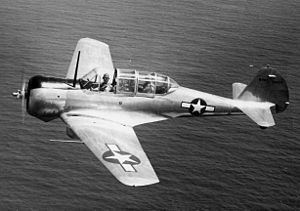Top speed 319 km/h Length 8.23 m First flight 1940 | Wingspan 11 m Introduced 1942 Manufacturer Curtiss-Wright | |
 | ||
The Curtiss-Wright CW-22 was a 1940s American general-purpose advanced training monoplane aircraft built by the Curtiss-Wright Corporation. It was operated by the United States Navy as a scout trainer with the designation SNC-1 Falcon.
Contents
Design and development
Developed at the Curtiss-Wright St. Louis factory, the CW-22 was developed from the CW-19 via the single-seat CW-21 light fighter-interceptor. The prototype first flew in 1940. With less power and performance than the CW-21, the two-seat, low-wing, all-metal CW-A22 had retractable tailwheel landing gear, with the main gear retracting rearward into underwing fairings.
The CW-22 was seen as either a civilian sport or training monoplane or suitable as a combat trainer, reconnaissance and general-purpose aircraft for military use. The prototype CW-A22 Falcon (U.S. civilian registration NC18067) was used as a company demonstrator and is one of four of the type still in existence. An SNC-1 is on display at the U.S. Navy's National Museum of Naval Aviation, at NAS Pensacola, Florida.
Operational history
The main customer for the aircraft equipped with the Wright R-975 Whirlwind air-cooled radial engine was the Royal Netherlands East Indies Army Air Force and 36 were exported. The aircraft had to be delivered to the Dutch in Australia due to the advancing Japanese forces. A developed version, the CW-22B, was sold to Turkey (50), the Netherlands East Indies (25) and in small numbers in South America. Some of the Dutch aircraft were captured and operated by the Imperial Japanese Army Air Force. The CW-22 and CW-22B were armed with two machine guns, one fixed.
An unarmed advanced training version (CW-22N) was demonstrated to the United States Navy. To help to meet the expanding need for training, the Navy ordered 150 aircraft in November 1940. Further orders brought the total to 305 aircraft which were designated SNC-1 Falcon.
Variants
Operators
Survivors
Specifications (SNC-1)
Data from
General characteristics
Performance
